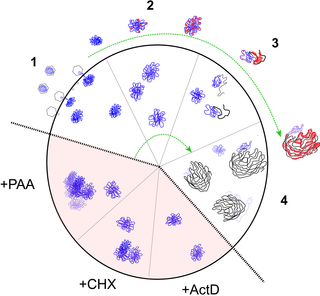PLoS Pathogens ( IF 5.5 ) Pub Date : 2017-11-09 , DOI: 10.1371/journal.ppat.1006721 Eiki Sekine , Nora Schmidt , David Gaboriau , Peter O’Hare

|
We investigated the spatiotemporal dynamics of HSV genome transport during the initiation of infection using viruses containing bioorthogonal traceable precursors incorporated into their genomes (HSVEdC). In vitro assays revealed a structural alteration in the capsid induced upon HSVEdC binding to solid supports that allowed coupling to external capture agents and demonstrated that the vast majority of individual virions contained bioorthogonally-tagged genomes. Using HSVEdC in vivo we reveal novel aspects of the kinetics, localisation, mechanistic entry requirements and morphological transitions of infecting genomes. Uncoating and nuclear import was observed within 30 min, with genomes in a defined compaction state (ca. 3-fold volume increase from capsids). Free cytosolic uncoated genomes were infrequent (7–10% of the total uncoated genomes), likely a consequence of subpopulations of cells receiving high particle numbers. Uncoated nuclear genomes underwent temporal transitions in condensation state and while ICP4 efficiently associated with condensed foci of initial infecting genomes, this relationship switched away from residual longer lived condensed foci to increasingly decondensed genomes as infection progressed. Inhibition of transcription had no effect on nuclear entry but in the absence of transcription, genomes persisted as tightly condensed foci. Ongoing transcription, in the absence of protein synthesis, revealed a distinct spatial clustering of genomes, which we have termed genome congregation, not seen with non-transcribing genomes. Genomes expanded to more decondensed forms in the absence of DNA replication indicating additional transitional steps. During full progression of infection, genomes decondensed further, with a diffuse low intensity signal dissipated within replication compartments, but frequently with tight foci remaining peripherally, representing unreplicated genomes or condensed parental strands of replicated DNA. Uncoating and nuclear entry was independent of proteasome function and resistant to inhibitors of nuclear export. Together with additional data our results reveal new insight into the spatiotemporal dynamics of HSV genome uncoating, transport and organisation.
中文翻译:

使用生物正交化学和超分辨率显微镜观察HSV基因组核进入和压实状态转变的时空动态
我们使用包含掺入其基因组的生物正交可追踪前体的病毒(HSV EdC),研究了感染开始期间HSV基因组运输的时空动态。体外测定显示,HSV EdC与固体支持物结合后可诱导衣壳结构发生变化,从而允许与外部捕获剂偶联,并证明绝大多数单独的病毒体均含有生物正交标记的基因组。使用HSV EdC在体内,我们揭示了感染基因组的动力学,定位,机制进入要求和形态转变的新颖方面。在30分钟内观察到脱壳和核输入,基因组处于确定的压实状态(衣壳体积增加了约3倍)。游离的胞质未包被基因组很少(占总未包被基因组的7-10%),这可能是由于接受高颗粒数的细胞亚群的结果。未包被的核基因组在凝结状态下经历了暂时的过渡,而ICP4与初始感染基因组的缩合灶有效结合,随着感染的进行,这种关系从残留的更长寿命的缩合灶转移到了日益解压缩的基因组。抑制转录对核进入没有影响,但是在没有转录的情况下,基因组作为紧密聚集的病灶而持续存在。在没有蛋白质合成的情况下,正在进行的转录揭示了一个独特的基因组空间簇,我们将其称为基因组聚集,这是非转录基因组所没有的。在没有DNA复制的情况下,基因组扩展为更多的缩合形式,这表明存在额外的过渡步骤。在完全感染的过程中,基因组进一步解聚,在复制区室中弥散有低强度的弥散信号,但经常在周围留有紧密的病灶,代表未复制的基因组或复制的DNA的亲本链。脱壳和核进入与蛋白酶体功能无关,并且对核输出抑制剂有抵抗力。











































 京公网安备 11010802027423号
京公网安备 11010802027423号